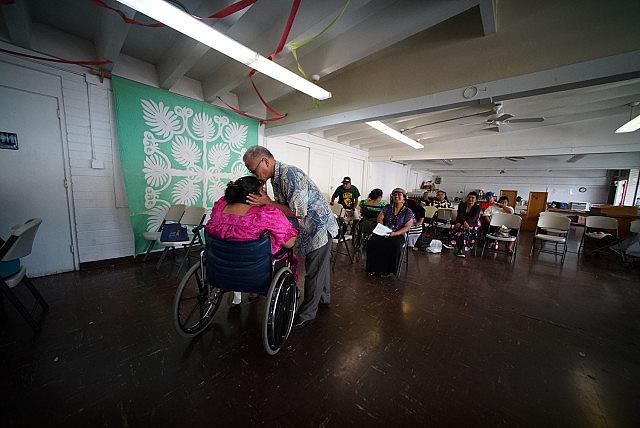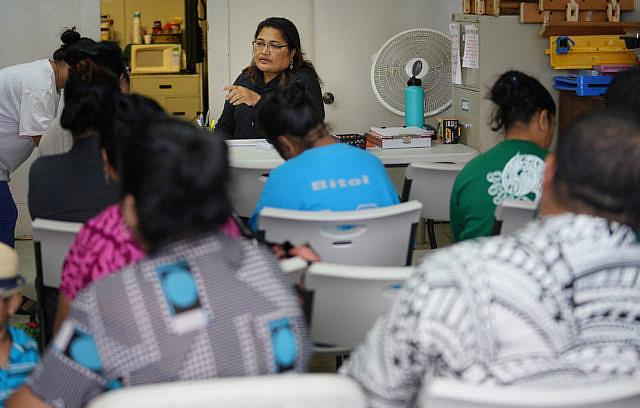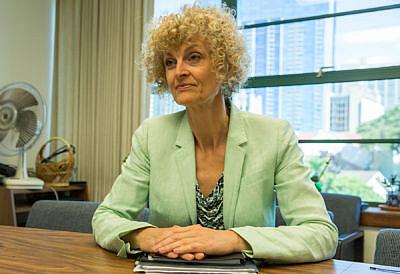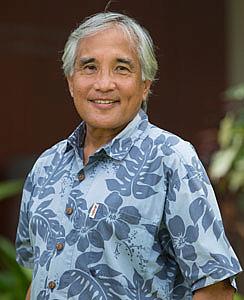Hawaii Wanted To Save Insurance Money. People Died
This article is part of a larger project by Anita Hofschneider, produced with support from the 2020 National Fellowship and a grant from the Dennis A. Hunt Fund for Health Journalism.
Her other stories include:
Community Leaders: State Is Failing Pacific Islanders In The Pandemic
Hawaii's Pandemic: Hardest Hit Communities Part 1: Hawaii Wanted To Save Insurance Money. People Died
Hawaii's Pandemic: Hardest Hit Communities Part 2: Health Officials Knew COVID-19 Would Hit Pacific Islanders Hard. The State Still Fell Short
Hawaii Researchers: State Must Support Pacific Islanders In The Pandemic
Pacific Islanders Have The Highest COVID-19 Death Rate In Hawaii
Women Were Already Struggling At Work. The Pandemic Is Making It Worse
Here’s What Honolulu Is Doing To Test Hard-Hit Communities For COVID-19
Kalihi Has The Worst COVID-19 Outbreak In Hawaii. Here’s How The Community Is Responding
Hawaii COVID-19 Data For Race And Ethnicity Is Missing
Hawaii Pacific Islanders Are Twice As Likely To Be Hospitalized For COVID-19
Hawaii's Pandemic: Hardest Hit Communities Part 3: Pacific Islanders Can’t Return Home During COVID-19 — Even To Bury Their Loved Ones
Hawaii's Pandemic: Hardest Hit Communities Part 4: The Pandemic Is Hitting Hawaii’s Filipino Community Hard

After Gov. David Ige removed access to public health insurance for poor, sick migrants from Micronesia, many died, according to a new study.
Cory Lum/Civil Beat
When Josie Howard heard that Gov. David Ige planned to push thousands of low-income Pacific Islander migrants off state-funded public health insurance in 2015, she worried about what that would mean for her community.
Howard, a Chuukese community leader, pictured patients waiting until they were really sick before going to an emergency room. She had flashbacks to the first time the state tried to cut coverage for Micronesian migrants under former Gov. Linda Lingle in 2009. She remembered hearing about cancer patients and people on dialysis who couldn’t get the treatment they needed. She was afraid people might die.
Her fears were confirmed by University of Hawaii researchers last week. A new study found that the mortality rate for Micronesians in Hawaii has grown every year between 2015 and 2018, curving upward compared with that of white and Japanese residents.
Approximately 94 additional Micronesians died between 2015 and 2018 after the Ige administration removed the migrant community from Med-QUEST — the state version of Medicaid that provides health coverage for impoverished people — and transferred them onto more expensive private insurance.
“Oh, I’m not surprised,” Howard said of the higher mortality rate. “But what’s next? Is this going to really change anything?”
After Gov. David Ige removed access to public health insurance for poor, sick migrants from Micronesia, many died, according to a new study. Cory Lum/Civil Beat
Still, she still has some hope. Perhaps decision-makers will read this study and realize these statistics represent real people, she said.
The study comes as Hawaii’s coronavirus pandemic surges to record levels, with daily case counts in the triple digits. On Friday, the state reported that 27% of all confirmed coronavirus cases are among non-Hawaiian Pacific Islanders, even though they make up just 4% of the population.
It’s a disparity that far eclipses any other in the state. And it brings renewed urgency to calls to reinstate health care coverage for Hawaii’s Micronesian community, which tends to get sick younger and with more serious illnesses than other ethnic groups. As Hawaii workers who lost their jobs due to pandemic shutdowns flock to Med-QUEST, those who are citizens of Palau, the Marshall Islands or the Federated States of Micronesia don’t have that safety net.
But the same pandemic that is making more Pacific migrants sick is also wreaking economic havoc, making it unlikely that they’ll get health coverage anytime soon. The Ige administration wasn’t willing to pay for their insurance in 2015, when the state was projecting tens of millions in extra revenue. Even in good times, Micronesians have little to no political sway in Hawaii, and now the state is scrambling to plug a major budget shortfall.
In Congress, Hawaii’s delegation is pushing for Medicaid reinstatement but so far has been stymied in the Republican-controlled Senate.
Neal Palafox, a physician and professor at the University of Hawaii Cancer Center, said the new mortality study is good data to have but it’s also predictable.
“The political will is not going to change until the people in Hawaii push it,” he said. He’s not confident that will happen. “A lot of them don’t feel that that vulnerable population is important or it’s not their priority.”
‘The Consequences Were Devastating’
In 2015, the Honolulu Star-Advertiser reported the state expected to save about $29.2 million by transferring 7,617 non-U.S. citizens off of Med-QUEST and onto private insurance.
Not every low-income Micronesian migrant in Hawaii was affected. Pregnant, blind and disabled adults still got access to public health insurance, as did children and the elderly.
Teresa Molina is an economist at UH. Steve Cohn
The state helped fund Howard’s organization, We Are Oceania, tapping her to provide community outreach and facilitate the transition. Some extremely poor people got private or public subsidies to help them afford their co-pays. But it wasn’t enough.
“The share of people dying among Micronesians increased much more after this policy than when you compare it to the increases in white mortality rates and Japanese mortality rates,” explained Teresa Molina, an economist and assistant professor at the University of Hawaii and lead author on the study.
A separate University of Hawaii study last year found that after the policy change, fewer Micronesians went to the hospital and uninsured emergency room visits rose.
“This was a middle ground and still the consequences were devastating,” said Tetine Sentell, a co-author of the mortality study and professor at the University of Hawaii Office of Public Health Studies. “I hope policymakers see that as the very real consequences of numbers in a spreadsheet.”
Tetine Sentell is a professor at UH. Courtesy of UH
Citizens of the three Pacific nations can live and work in the U.S. indefinitely due to defense agreements dating back to the Reagan administration known as the Compacts of Free Association. About 16,000 of them live in Hawaii, according to American Community Survey data between 2013 and 2017.
Many come for similar reasons that Hawaii residents move to the mainland: to find better-paying jobs and better education. Others are medical refugees, seeking life-saving medical care such as dialysis and chemotherapy that isn’t available in their home countries. Marshallese residents in particular struggle with cancers associated with U.S. nuclear testing in the region.
But accessing health care isn’t easy. Even before the pandemic, about 14% of Micronesians were uninsured, more than three times higher than the state average — even taking into account nearly 9,000 Micronesians in Hawaii who are U.S. citizens and remain eligible for Med-QUEST.
Since 2015, Howard has thrown herself into helping her fellow migrants get health coverage. She brings in a nurse every month to her Kalihi office to check migrants’ vital signs. She set up calls with neighbor island advocates to facilitate health insurance sign-ups. She partnered with an urgent care center so health care providers could help people enroll in coverage.
Josie Howard from Chuuk assists her fellow citizens of COFA nations with enrolling in health care insurance at We Are Oceania’s office in Kalihi in December 2018. Cory Lum/Civil Beat
And every fall during the open enrollment period, she and her staff work long hours to help both Micronesians and other immigrants who aren’t eligible for Medicaid to sign up for insurance through the federal marketplace. First, they have to apply to Med-QUEST and get rejected. Then they have to apply for insurance through the federal website. It’s confusing and complicated and the website isn’t translated into any Pacific Islander languages.
Howard and her staff spend hours interpreting information into multiple languages and helping people who don’t have access to computers navigate the complex process.
“This is the effort we have to take in order to get our people covered,” she explained. It doesn’t always work. Sometimes, people walk in asking for help getting on insurance after the sign-up period is closed. She has to turn them away, even though she can see that they are very sick.
Cost Savings
The Affordable Care Act insurance marketplace wasn’t intended for low-income families. When former President Barack Obama pushed for the health care law, he also pushed to expand Medicaid. That’s the mechanism that the federal government has relied on since the 1960s as a safety net for people in poverty.
But not everyone is eligible for Medicaid. Unauthorized immigrants aren’t, and the 1996 Welfare Reform Act slashed access for some legal immigrants too. Green card holders suddenly needed to be in the U.S. for a full five years before they’d be eligible for the program. And anyone considered a “nonimmigrant” wasn’t eligible either — including COFA migrants.
Their legal status bars access not only to Medicaid but also programs like federal disaster assistance, food stamps and federal disability insurance. Today COFA migrants like Howard may live, work and pay taxes in the U.S. for decades but they are effectively treated under the law like short-term residents.
Hawaii initially covered migrants after they were cut from Medicaid, but doing so became increasingly unpopular as costs grew and federal reimbursements fell far short.
Judy Mohr Peterson from the state Med-QUEST office said the mortality increase is sad but there are other factors that could have affected it apart from the policy change.
Peterson said the state hasn’t continued to tally its cost savings from the 2015 shift. But a rise in uninsured hospital visits could mean that the state is paying for care to some extent. Peterson said the state reimburses hospitals for uninsured emergency room visits but she didn’t have the data available about how much is spent.
Judy Mohr Peterson is Hawaii’s Med-QUEST director. Anthony Quintano/Civil Beat
In the absence of public health insurance, costs have shifted to migrants, some of whom have racked up hefty medical debt. When they can’t pay, it may fall to hospitals.
Tim Halliday, an economist at UH who is also a co-author of the mortality study, said lack of insurance could ultimately drive up health care costs if people wait to seek care until diseases worsen.
Loss of life also has a cost, too. Halliday noted that when the Environmental Protection Agency calculates the value of a life, they estimate an individual is worth $10 million. So if 50 people died, that’s $500 million.
But he thinks that focusing on money misses the point.
“The thing is, we really are trading off dollars for life years,” Halliday said. “It’s not like we are going to insure them and save money. We are saving money and sacrificing lives. That should be enough to get people interested.”
Lack of Political Will
That might be not enough, according to Palafox from the University of Hawaii.
Palafox is skeptical that the political will exists at either the federal or state level to restore coverage. He noted a 2019 report by the U.S. Civil Rights Commission that found that only one congressional proposal out of more than two dozen related to COFA passed in the past decade.
“It really tells you, the system — including the legislative system — doesn’t understand this problem of inequity and further they’re not willing to address it,” he said.
He noted that there was plenty of data showing the community had poor health outcomes before Ige made the call to remove Micronesian migrants’ access to public health insurance.
Neal Palafox is a physician and professor at the University of Hawaii. Courtesy of UH

